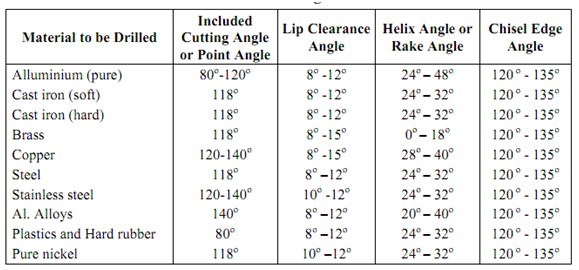Important Angles of a Drill
Many different angles, as shown in Fig 11, are provided on a drill so as to ensure an efficient metal cutting. The main angles are the following.
It is also known as the helix angle. It is the angle formed between a plane containing the drill axis and the leading edge of the land. It can have a positive, negative or zero value. For a right hand flute its value is positive, for a left hand flutes negative and for parallel fluted drill its value is 48o. However, 16o to 32o range is quite common for normal materials. Higher values of the helix angle are suitable for softer materials and lower values for harder materials. The power or the torque required to rotate the drill is greatly influenced by this angle. Larger the value of this angle, lesser will be the torque required and vice-versa.
It is also known as cutting angle. Its most commonly used value for a large variety of materials is 118o. However, it varies from 80o to 140o. Smaller point angle is favoured for brittle materials and the larger one for harder and tougher materials. It is the angle included between the two opposite lips of a drill, measured in a plane containing the axis of the drill and both the lips.
The angle formed between the flank and a plane normal to the drill axis, calculated at the periphery of the drill, is called lip clearance angle. Its value varies from
8o to 15o for most of the drills, but 12o angle is the most common. This angle is formed as a result of grinding the relief adjacent to the cutting edges to enable easy entry of the drill.
When a drill is viewed from its end, there appears to be an obtuse angle formed between the lip and the chisel edge. This angle is called the chisel edge angle. It determines the clearance on the cutting lip near the chisel edge. The greater this angle the larger will be the clearance. Normally this angle varies between 120o and 135o, although on some smaller drills it may be as large as 145o.
The common range of values of these four principal drill angles is given in Table 11.
Table 11: Standard Angles Used in Drills
